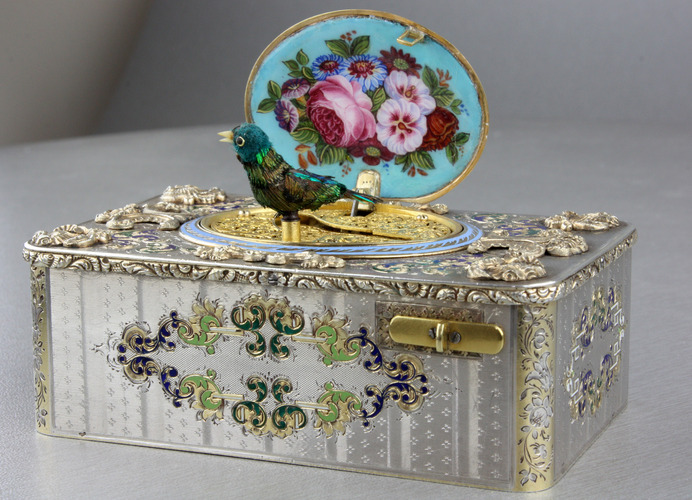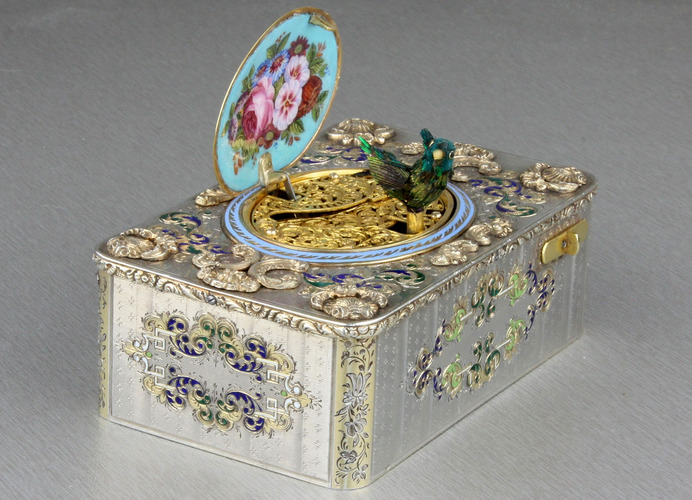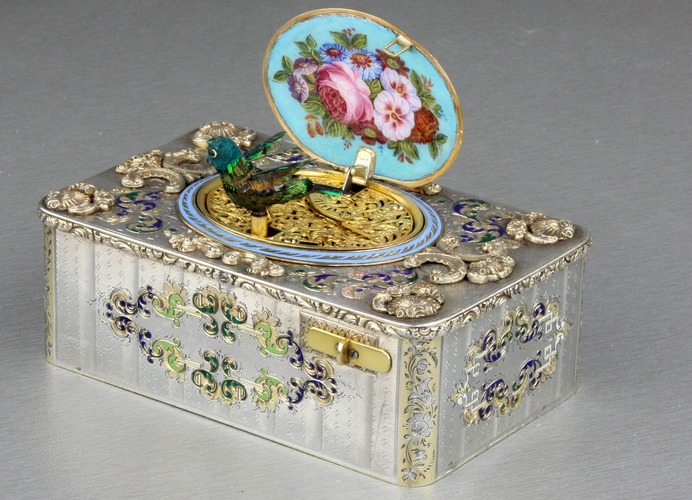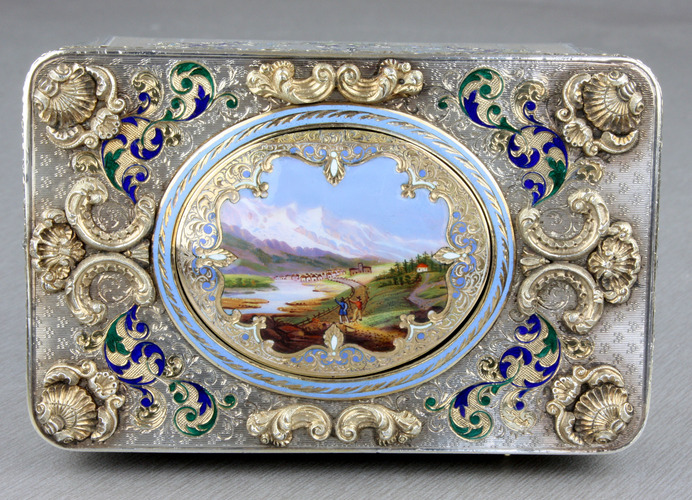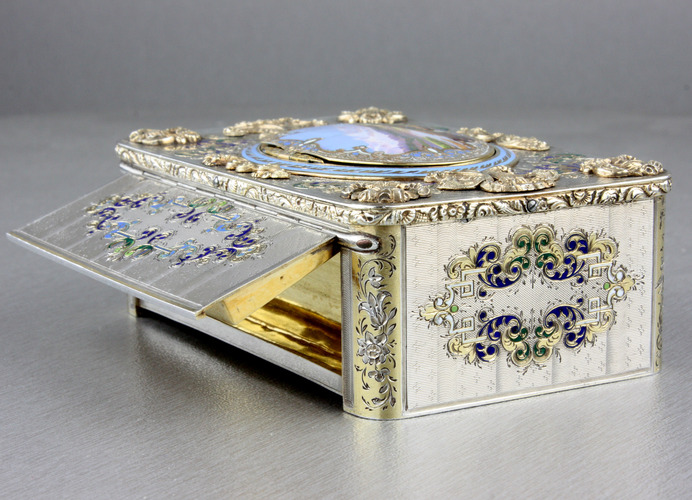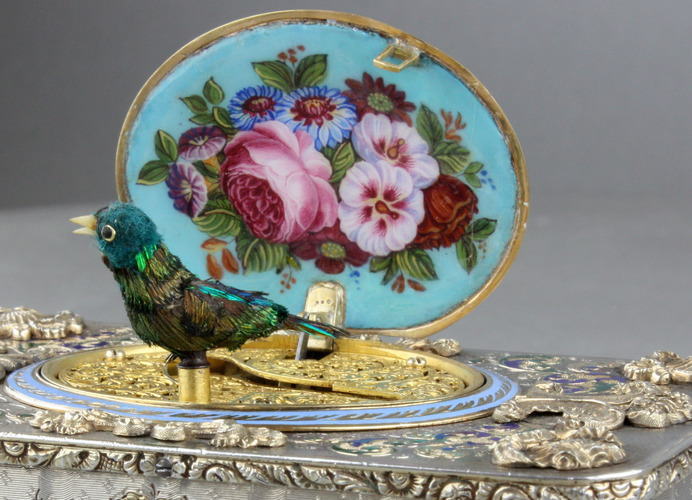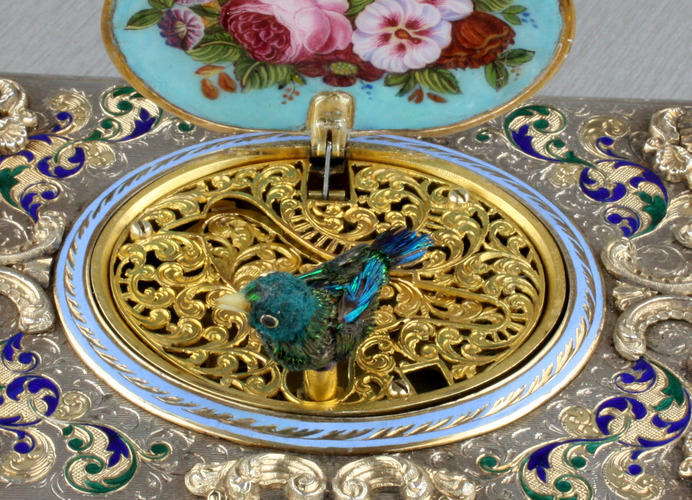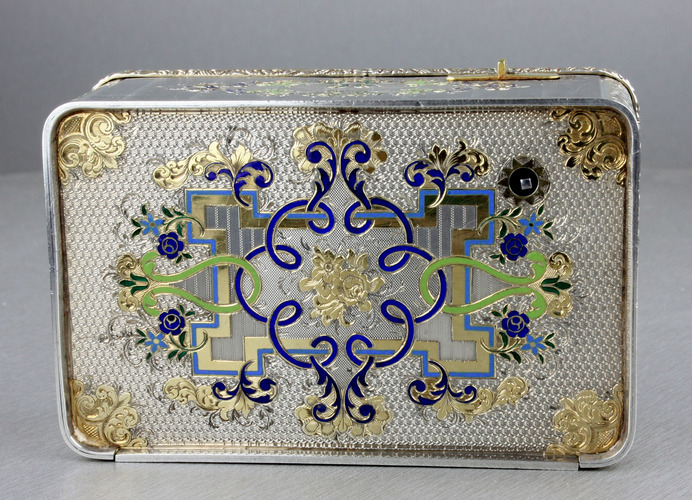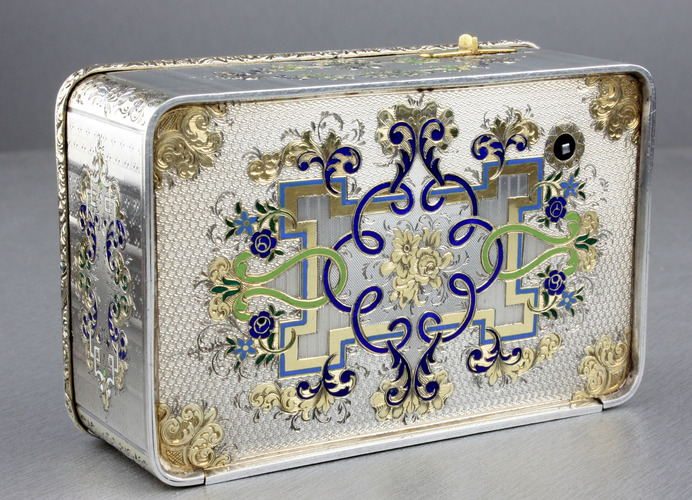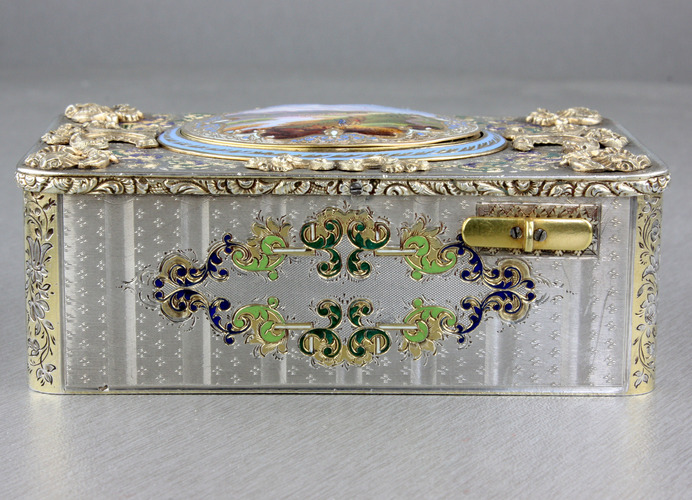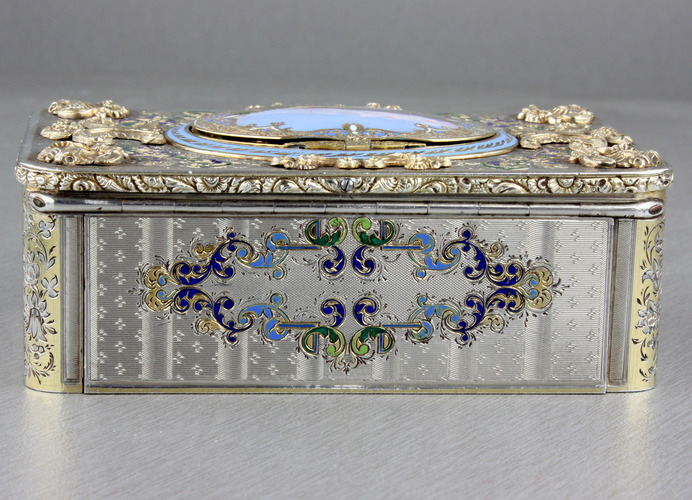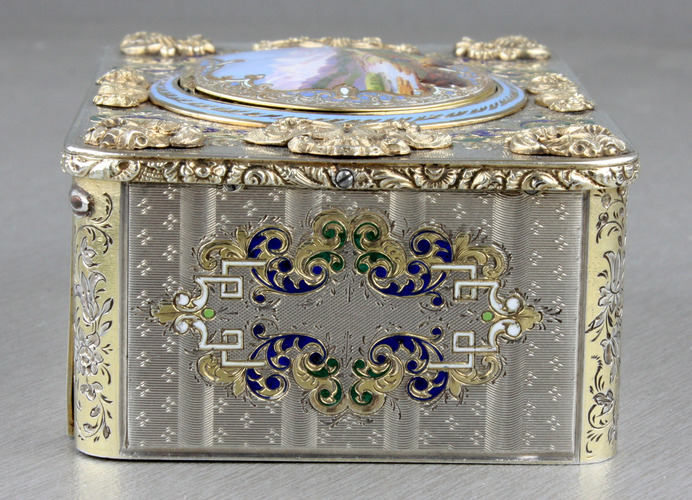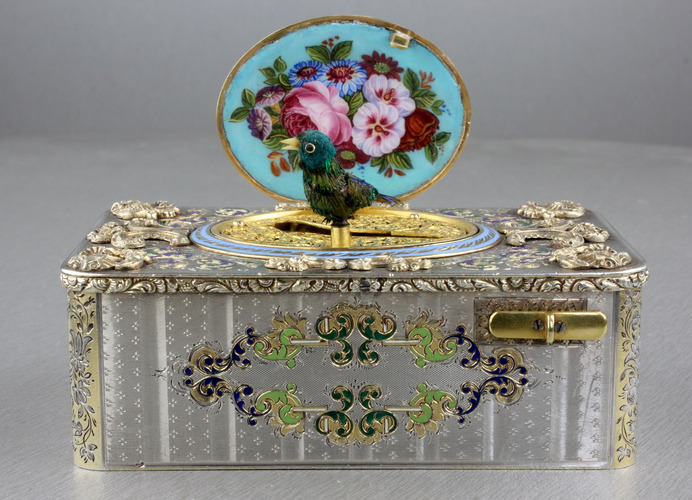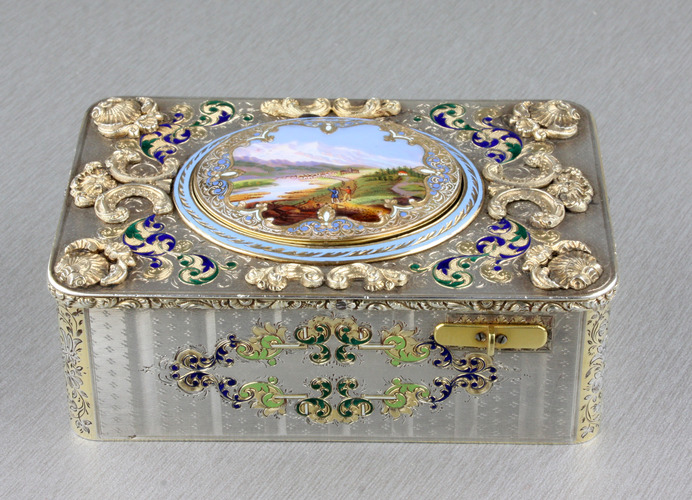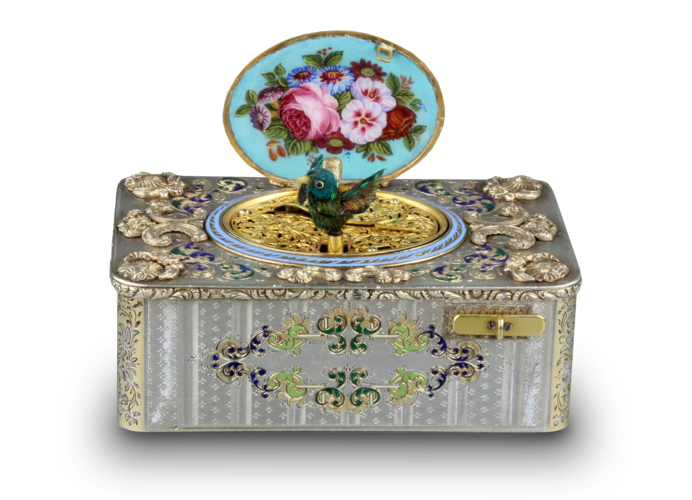
An exceptionally important and early silver, parcel-gilt, enamel and gilt appliques singing bird box, by Charles Bruguier
An exceptionally important and early silver, parcel-gilt, enamel and gilt appliqués singing bird box, by Charles Bruguier,
Swiss
circa 1820
one of the finest Fusee movements yet seen,
complete with operating lid-lock mechanism,
Serial Number 3 - Charles Bruguier's third masterpiece.
Thought lost, then discovered, now delivered...
When wound and the silver-gilt start/stop slide actuated, the bird lid opens as the bird magically appears, opening and closing bone beak, turning head backwards and forwards, flapping both wings to a fast pace, bobbing tailfeather and turning entire body from side-to-side, all perfectly synchronised to the slight paused sequential birdsong, ending when the bird disappears as the lid closes once more.
With the eight cam-stack producing the very early and much prized 1-2-3-4 sequential song order, slight-tapered rectangular bellows and delicate fan governor, stamped tobaseplate with C BRUGUIER Á GENEVE and the number 3, next to pattern stamp 4 repeated to top plate at ninty-degrees to serial number, rounded plate pillars, blued adjustment screws and the early type whistle chamber with rounded main valve housing.
The bird with astounding full iridescent feathered plumage, with olive green and black streaked undertones, layered with the bright emerald green flashes to both body and wing tips, head with matching matt green and tailfeather with banded feathers to include deep lagoon blue field, rising up through the magnificent silver-gilt finely pierced and chased grille, with sweeping scrolls and lattice bars, wide seamless bird-form centrum, lid-lock void with plain outline, lid interior with a sublime painted enamel spray of summer flowers with the large Handel pink rose and twin camellias to centre, all on soft Eau de Nil ground.
The bird lid top with the finest domed pictorial enamel study, of a valley river settlement at the foot of the Alps, large church beside dwellings in distance, a boardwalk leading there from the foreground where two country folk stand pointing the way, fir tree line coming into view on the right and the rocky stumps which make up the river banks overshadowed by the massive snow-topped mountain ridge above heading right off in the far distance, under the pale blue sky.
This shaped study framed by wide border, tooled and chased with great detail, and with accompaniment from the many inset enamels to the drops and scrolls in white and clipper blue, tooling right up to and including hinge bar, surrounded by the border of further inset clipper blue enamel and centrally tooled leaf sprigs.
The case of exceptional quality and refinement, with the main lid top having tooled petit line and star cluster ground, upon which three-dimensional twinned appliqués of opposing Rococo C scrolls and swept crests adorn the top and side fields, whilst the corners have shells, all unified by the incredible inset enamel in deep green and cobalt blue, tooled with even finer detail to complete the swept flowering branches further, edge with close-detail rose head and leaf frieze, and each corner with chased poppy branches in two-tone hues with the entire foreground of each in parcel gilt.
The front, back with the petit infill at its full emergence, with large geometric matrix to each panel, in white, lime green, dark green and cobalt blue enamels, tooled with open leaf roundels and delicate sprigs, petit-point ground within matrixes, the ground around with breath-taking concave-effect tooled columns, alternating between wave-line and clustered bands, the sides with the repeating panels to a smaller scale and the white infil bars terminating with Greek Key returns.
Underside with the main surprise display, with massive, almost full-frame sized geometric matrix with Highland-cornered frame and daisy heads in clipper blue, interlocking ribbon-chase splat, rose heads and branches in cobalt blue, daisy leaves in dark green and the twin half hour-glass loops in lime green, all enhanced by the tooled gilt flowers, swags and central rose spray, on complex dot-tooled ground, overseen by the flowering scrolls issuing from all four corners, hidden key compartment with superb gilt interior at rear.
size - 3.1/2in. wide, 2.1/4in. deep, 1.3/8in. high - (9 x 5.7 x 3.5cm)
Point of Interest -
Of the many fusee singing bird boxes Douglas Fisher of London have handled, this one is without a doubt the finest Charles Bruguier ever to surface.
It also happens to be the earliest Charles Bruguier yet found and its condition is unimaginably sublime.
The lid-lock feature is present and operative. Very few of the early Bruguier boxes have this, as the mechanism was soon refined and designed to overcome the requirement of such a device. The purpose is of course to make sure the lid does not freely open if turned upside down or during transit, due to the lid bracket being half gravity accompanied to complete the close position on shut-down.
The work on the case is a pure triumph of excellence, matched perhaps by the likes of Rochat and Frisard. Tooling just not able to be fully seen by the naked eye is one matter - not being in a position to see the last few details of it with the aid of a loupe is quite another. We do not know what sort of optical apparatus was present on Bruguier'sworkbench, but it must have been a lens with an astonishing field of view.
This is one of those antique fusee singing bird boxes, one of very few in the world, which is for want of a better use of phrase, perfect. Perfect in proportion and execution, for its design features and for its reveal as Bruguier's third masterpiece.
Savour the divine object, not just for its purpose and pose, but also for its survival.
| STOCK No | 1532 |
| AVAILABILITY | Sold |
| PRICE | Sold |



